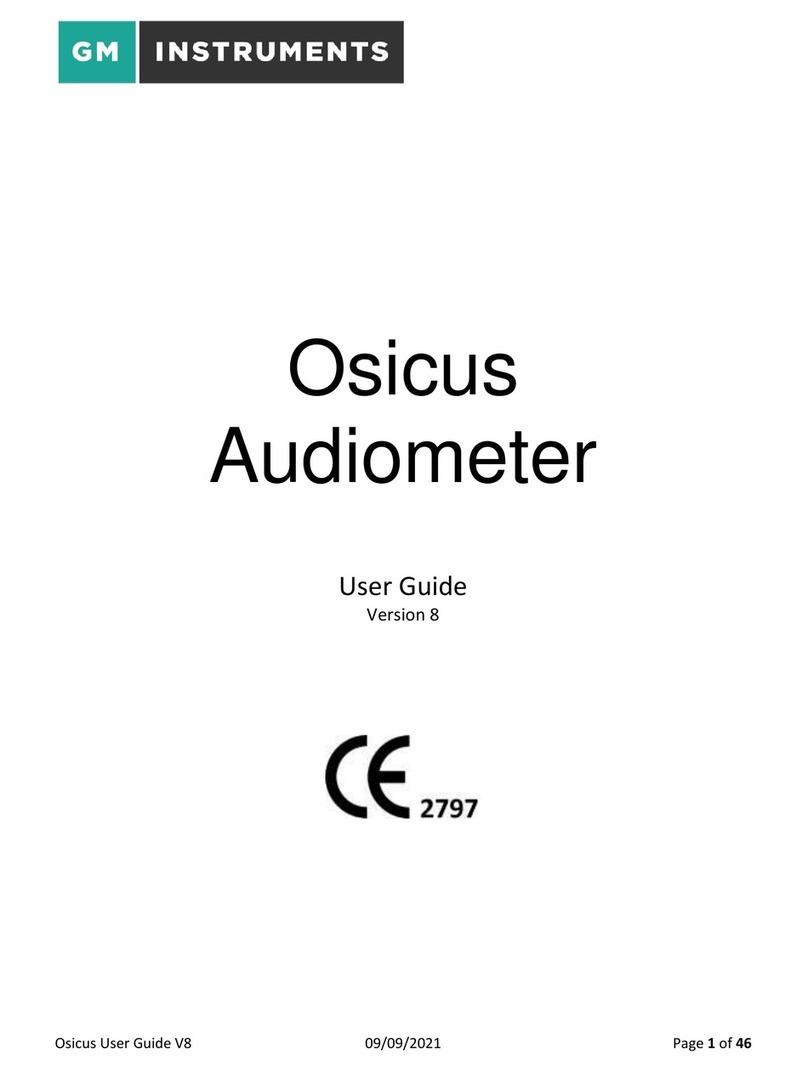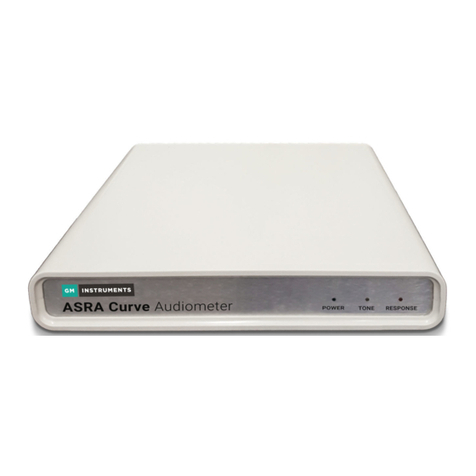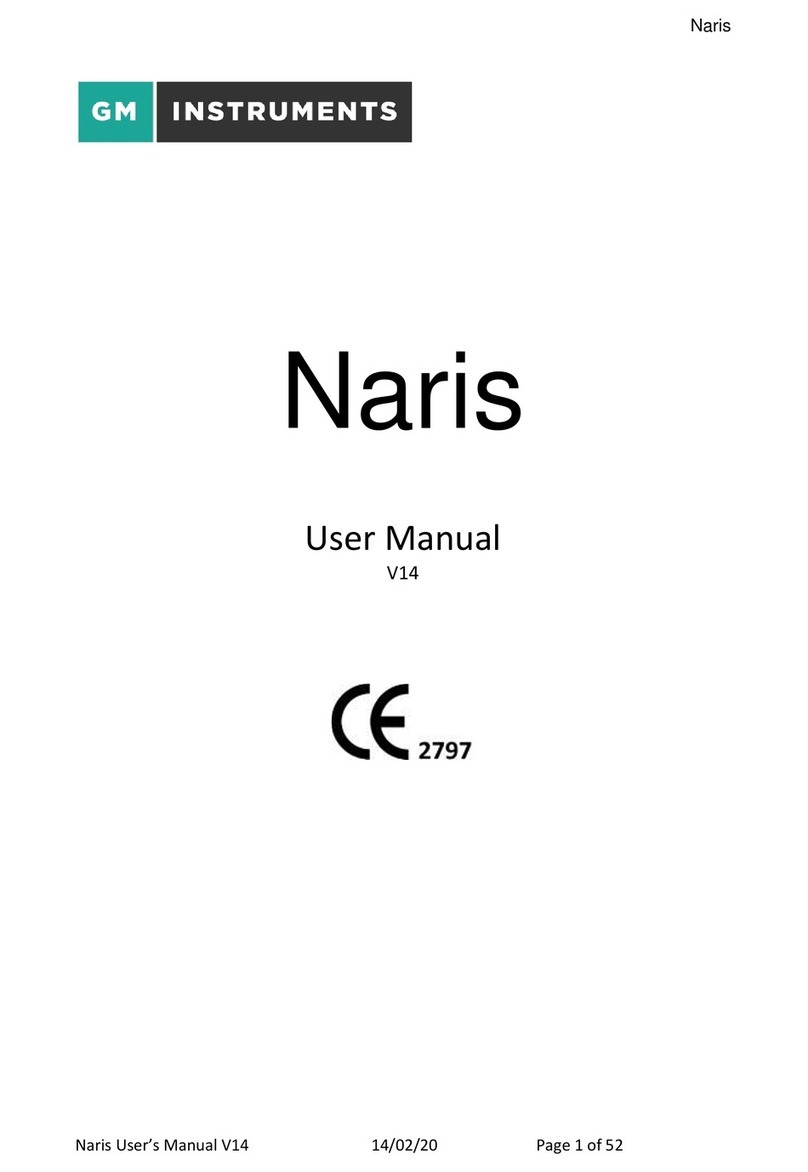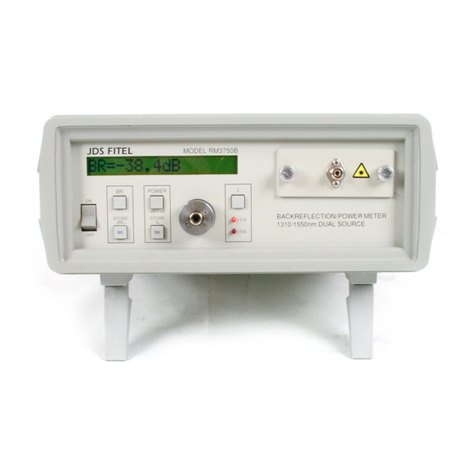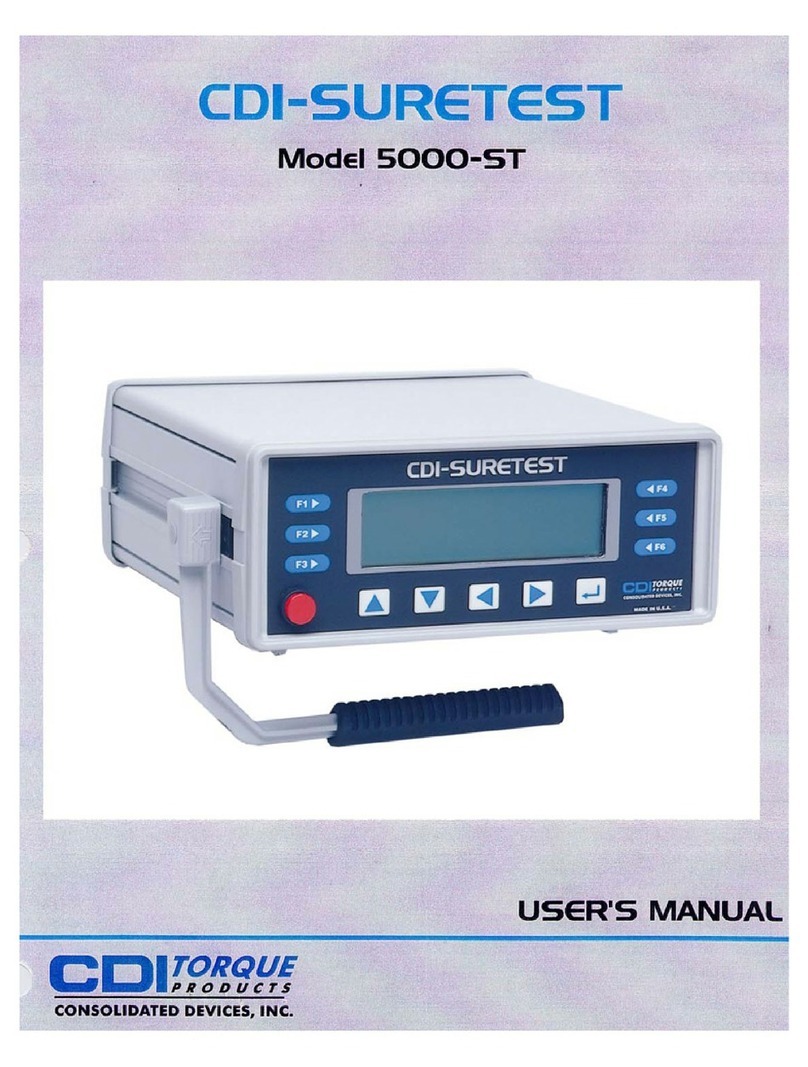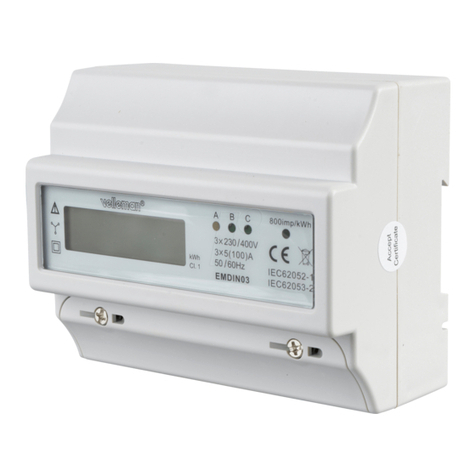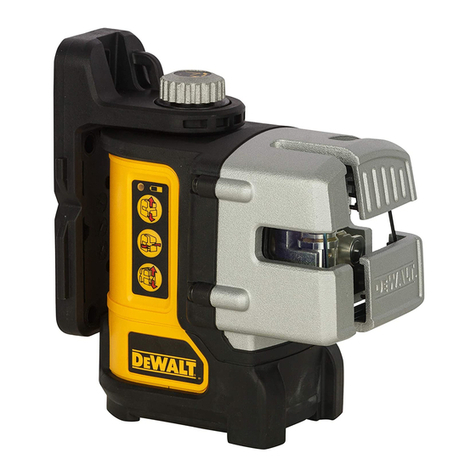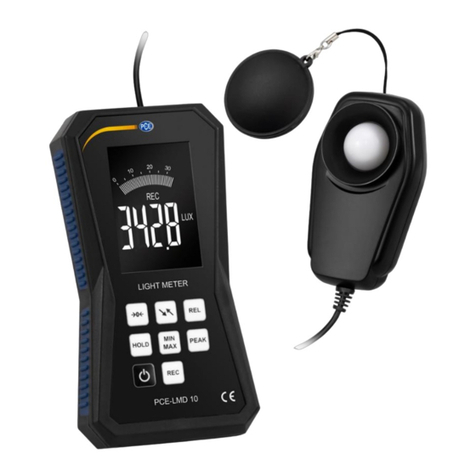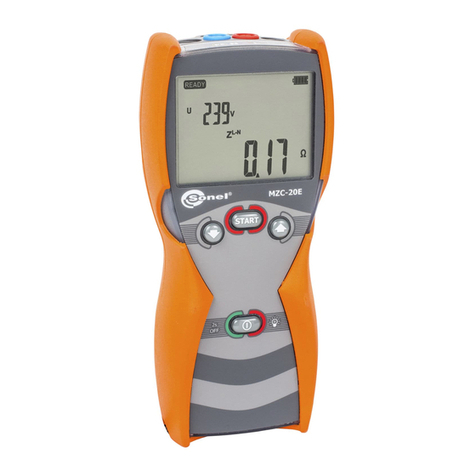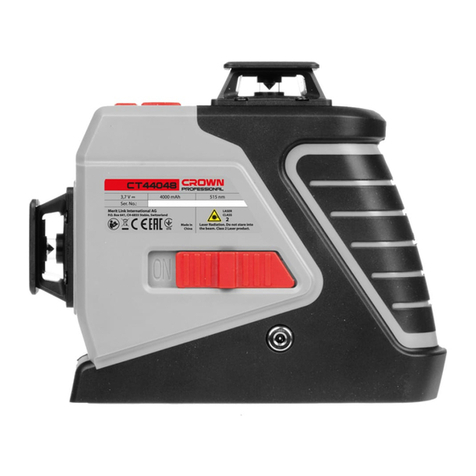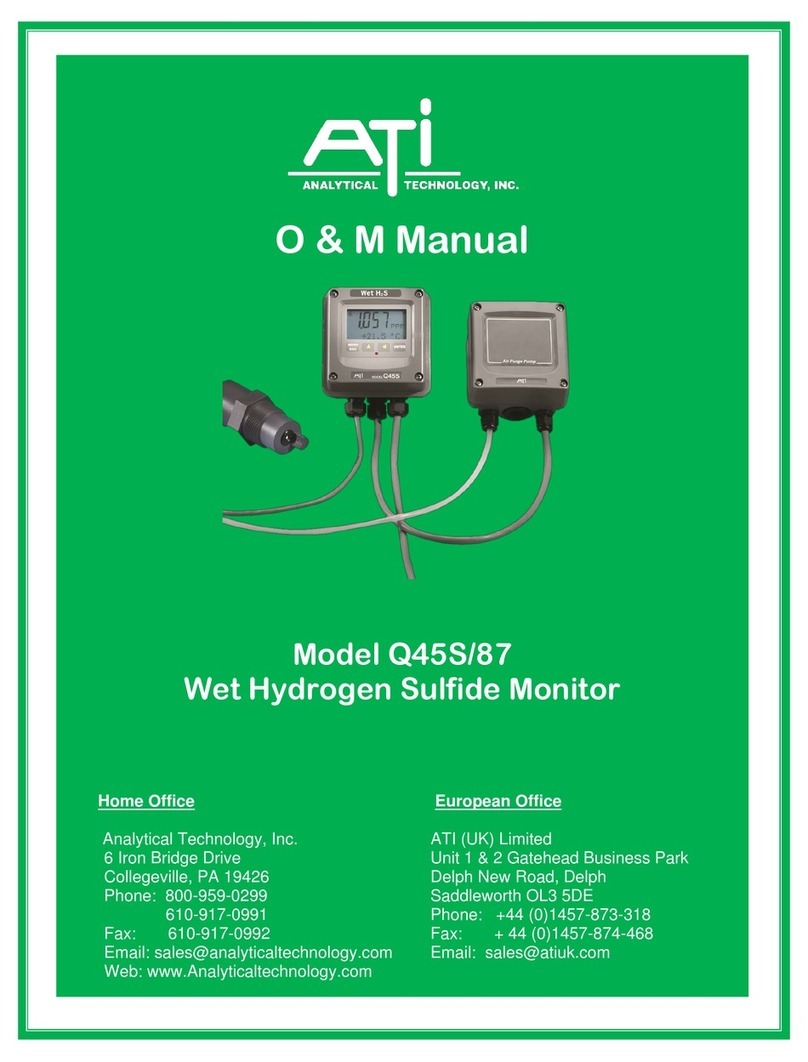GM INSTRUMENTS NR6 User manual

Rhinomanometer NR6
NR6 User’s Manual V 16 14/02/2020 P1 of 34
Rhinomanometer
NR6
User Manual
and Installation Notes
V16

Rhinomanometer NR6
NR6 User’s Manual V 16 14/02/2020 P2 of 34
TABLE OF CONTENTS
IMPORTANT SAFETY INFORMATION
WARNINGS/ CAUTIONS PAGE 3
STORAGE PAGE 6
TECHNNICAL SPECIFICATION PAGE 6
SYMBOLS PAGE 7
INSTALLATION PAGE 9
RHINOMANOMETRY OVERVIEW PAGE 10
ANTERIOR TEST PAGE 10
POSTERIOR TEST PAGE 11
PERFORMING A TEST PAGE 13
ANTERIOR METHOD PAGE 13
ANTERIOR TEST PROCESS PAGE 15
POSTERIOR METHOD PAGE 16
POSTERIOR MEASUREMENT PAGE 17
COMMON PROBLEMS AND TROUBLESHOOTING PAGE 18
ERROR MESSAGES Page 19
CLEANING OF PATIENT CONTACT PARTS PAGE 21
SUPPLIED PARTS PAGE 23
SPARE PARTS AND CONSUMABLES PAGE 23
MAINTENANCE MANUAL PAGE 24
CALIBRATION PAGE 24
MAINTENANCE PAGE 25
SERVICING PAGE 26
APPENDIX 1: ELECTROMAGNETIC COMPATIBILITY PAGE 28
APPENDIX 2: TECHNICAL INFORMATION PAGE 30
(RELATIVE to EN 60601-1:200)
APPENDIX 3: CARE OF FLOWHEADS PAGE 32
APPENDIX 4: DEFINITIONS FOR PAGE 34
CLEANING/DISINFECTING/STERILIZING

Rhinomanometer NR6
NR6 User’s Manual V 16 14/02/2020 P3 of 34
NR6 RHINOMANOMETER SAFETY INFORMATION
Read this Operating Manual before attempting to use the
Instrument.
WARNINGS
This Instrument is for indoor use, in a professional healthcare facility only and used as
described in this manual.
It should not be used near active High Frequency Surgical Equipment nor in the RF shielded
room of an ME system for magnetic resonance imaging, where the intensity of Electro
Magnetic disturbances are high.
Use of this equipment adjacent to, or stacked with, other equipment should be avoided
because it could result in improper operation. If necessary, this equipment and the other
equipment should be observed to verify they are operating normally.
Should the NR6 be affected by external influences such as those described above, it may not
perform correctly. Determination of correct operation can be easily assessed as described in
page 12 of this manual.
Use of accessories, transducers and cables other than those specified or provided by the
manufacturer of this equipment could result in increased electromagnetic emissions or
decreased electromagnetic immunity of this equipment and result in improper operation.
Portable RF communications equipment (including peripherals such as antenna cables and
external antennas) should be used no closer than 30 cm (12 inches) to any part of the ME
SYSTEM, including cables specified by the manufacturer. Otherwise, degradation of the
performance of this equipment could result.
This unit is a PC connected product. It is advisable not to touch the patient while using the
equipment.
The equipment should be positioned in such a way that it can be easily disconnected from a
mains powered PC. The operation of the system can be safely terminated by switching off
the PC, or removing the USB cable between the PC and NR6.
Applied Parts. The applied parts consist of single-use foam inserts, microfoam tape
(hypoallergenic elastic), tip connectors (Nylon), anterior or posterior tubing (Silicone), masks
(single-use /or reusable silicone) connected to an antiviral filter, flowheads and silicon rubber
tubing.
The system must not be used in the presence of flammable gases or in an environment,
which is susceptible to explosions. (Beware of oxygen, dust and anaesthetic gases)

Rhinomanometer NR6
NR6 User’s Manual V 16 14/02/2020 P4 of 34
The use of PC and Printer in the Patient Environment is defined below and must be followed
to ensure safety compliance of the instrument
Option 1: Patient Environment for Non –Medically approved PC & Printer
Patient Environment (3 metres)
Figure 1: Patient Environment for Non-Medically approved PC & Printer
If the PC and/or printer are non-medically approved then it should be positioned as shown in
Figure 1, out with the patient environment. The PC and/or printer must be compliant to
EN60950-1.
Option 2: Patient Environment for Medically approved PC & Printer
Figure 2: Patient Environment for Medically approved PC & Printer
If the PC and/or printer is compliant to BS EN 60601-1 and medically approved then the
Printer and PC can be positioned within the patient environment as shown in Figure 2.
In circumstances where the PC and /or printer are not medically approved but are to be used
within the patient environment then an isolation transformer, which is in compliance to BS
EN 60601-1 MUST be used to ensure safety compliance, or run the PC by only battery
without mains connection.
NR6
Rhinomanometer
Flowhead Tubing
(1 metre)
USB cable
(2 metre)
NR6
Rhinomanometer
USB cable
(2 metre)
Flowhead Tubing
(1 metre)
Patient Environment (3 metres)

Rhinomanometer NR6
NR6 User’s Manual V 16 14/02/2020 P5 of 34
CAUTIONS
Patient connection components may cause an irritation reaction in some patients. Use of
such components should be discontinued in patients who exhibit such a reaction.
Certain components are identified as single-use items. Single-use items should not be
reused as they could carry infections between subjects
Federal (USA) law restricts this device to sale by or on the order of a physician.
The use of an NR6 Rhinomanometer near to sources of electromagnetic radiation, such as
mobile phones, radio transmitters, x-ray equipment etc, may prevent it from functioning
correctly. Appendix 1 provides guidance on the Electromagnetic environment in which to
operate the instrument.
The NR6 Rhinomanometer is a medical instrument which has a Medical Device Directive
Classification of Class I with a measuring function.
Applied parts offer protection to the subject against electrical shock and in the event of a
single fault condition arising, leakage current will be limited to less than 0.5 mA.
Any incident, which results in actual or potential injury or death to a subject while using an
NR6, should be immediately communicated to GM Instruments at the address on page 8.
Non-medical equipment such as computers and printers should be kept out of reach of
subjects being tested as such equipment does not comply with medical safety standards,
please see the earlier definitions shown in Figure 1. The combination of the
Rhinomanometer and computer and/or printer make up a medical system, refer to the
current version of EN 60601-1 to ensure compliance.
If the PC is allowed to go into sleep mode, the USB interface is powered down. When brought
out of sleep mode, the PC does not re-initialise the USB interface, and therefore it is effectively
not present. A solution is to remove the USB connection at the PC or instrument side then re-
connect. That may be sufficient, but if not, save any results, then close down the instrument
software and restart it.
Servicing can only be carried out by GMI approved and
authorised personnel. No modifications are allowed.

Rhinomanometer NR6
NR6 User’s Manual V 16 14/02/2020 P6 of 34
STORAGE
The NR6 Rhinomanometer and its accessories should be stored within the following
temperature and humidity ranges:
Temperature -40C to +60C
Humidity 20% to 80% RH non-condensing
Pressure 50 to 106 kPa
TECHNICAL SPECIFICATION
Only factory-trained personnel or engineers familiar with the standard EN 60601 can
undertake servicing of the NR6 Rhinospirometer
Circuit Diagrams will be made available to competent persons on request
Medical CE Mark
The CE mark indicates that the device meets the requirement of
Annex V & VII of the Medical Device Directive 94/42/EEC
Standards
Safety
BE EN 60601-1 :2006 +A1:2013
EMC
BS EN 60601-1-2:2015
Performance
Flow Range
+/- 800cc/sec
Pressure Range
+/- 800Pa
Accuracy
+/- 2%
Operation Environment
Temperature
+15 o C to +35 C
Relative
Humidity
20% to 80% RH non-condensing
Pressure
50 to 106 Kpa
Duty Cycle
Continuous
Warm Up Time
5 minutes
Supply
USB taken from PC
Transportation and Storage
Temperature
-40 °C to +60 °C
Relative
Humidity
20% to 80% RH non-condensing
Pressure
50 to 106 Kpa
Mechanical Performance
Size
27 x 8 x 30 cm
Weight
2 Kg
Additional Technical Information (relative to EN 60601-1) is also provided in Appendix 2.

Rhinomanometer NR6
NR6 User’s Manual V 16 14/02/2020 P7 of 34
TABLE OF SYMBOLS USED
The following symbols appear on the NR6
Symbol
Meaning
Socket Type
Location
Connected Part
Refer to Instruction
Manual
ISO7010-M002
USB Connector
Type B
Instrument Back
Panel
Computer
(Via USB port)
Type B
Applied Parts
IEC 60417- 5840
Nozzles
Instrument Front
Panel
Silicone Rubber
Tubing *
Protective Earth
IEC 60417 - 5019
_
Instrument Back
panel - Internal
_
For connected parts marked * only connect the accessories supplied with
the instrument. These parts have been tested for use with the instrument
for compliance to standards IEC 60601-1 and IEC 60601-1-2.
Symbols used on labelling and packaging:
SYMBOL
MEANING
LOCATION
Manufacturer
ISO7000-3082
Instrument Label
Date of Manufacture
Where ZZZZ: Date of Manufacture
ISO7000-2497
Instrument Label
Serial Number
ISO7000-2498
Instrument Label
Consult Instructions for Use
ISO7000-1641
Instrument Label

Rhinomanometer NR6
NR6 User’s Manual V 16 14/02/2020 P8 of 34
0000
Council Decision 93/465/EC. Annex B(d)
+ 93/42/EC
Instrument Label
Do not re-use
IEC7000-1051
Consumables
Packaging-
Nosepieces
Non- sterile
ISO7000-2609
Applied parts
packaging-
Nosepieces
Temperature Limit
ISO7000-0632
Instrument Shipper
Packaging
Humidity Limitation
ISO7000-2620
Instrument Shipper
Packaging
Atmospheric Pressure limitation
ISO7000-2621
Instrument Shipper
Packaging
Mandatory Action Sign
ISO 7010- M001
Operating Manual
ADDRESS AND CONTACT DETAILS:
MANUFACTURED BY:
GM Instruments Ltd
Greig House
Annickbank Innovation Campus
Annick Road
Irvine
KA11 4LF
UK
TEL: +44 (0)1294 554664
WEBSITE: www.gm-instruments.com

Rhinomanometer NR6
NR6 User’s Manual V 16 14/02/2020 P9 of 34
INSTALLATION
Hardware and software have been provided with the NR6 Rhinomanometer to allow for the
determination of a well-defined assessment of the function of the nose and of recording
changes within it due to surgical intervention, allergic response, or other factors.
INSTALLING THE NR6 SOFTWARE
Installation of the NR6 Software is described fully in the accompanying manual titled “NR6
Software Manual”
INSTALLING THE NR6 HARDWARE
The NR6 Rhinomanometer can operate on any PC which runs a Windows based operating
system which has a free USB socket. Operate with PC and Printer as shown in the warnings
section
Once the software installation is complete then connect the USB cable from the PC into the
NR6
NR6 REAR VIEW AND CONNECTIONS
NOTE: LINK SOCKET ONLY USED WHEN CONNECTRED WITH A1 IN NARIS CONFIGURATION
NR6 FRONT VIEW AND CONNECTIONS
The NR6 box has four nozzles on it, which are colour coded:
Black is the pressure input, Blue is the pressure reference,
Red is the positive flow input, Green is the negative flow
input.
Connect each tube onto the input nozzle with the
corresponding coloured marker, i.e. black -> black, red -> red
etc.
Connect the free ends of the tubes to their corresponding coloured markers –green and red
tubes onto the green and red nozzles on the flowhead, and the tube marked blue onto the
mask port marked blue. If you are going to be making posterior tests, the tube marked black
will also go onto the mask nozzle marked black, but if anterior, it will go onto an anterior
tube connector. In this case the mask nozzle marked black should be closed, using the plug
provided
USB
SOCKET
LINK
SOCKET

Rhinomanometer NR6
NR6 User’s Manual V 16 14/02/2020 P10 of 34
RHINOMANOMETRY OVERVIEW
The measure of Rhinomanometer or nasal airway resistance depends on measuring nasal air
flow and the pressure producing that airflow:
Nasal airflow is collected by a mask, which must form an airtight seal round the face, and is then
passed through a pneumotachograph head in which the flow is converted to a pressure
differential. This differential is transmitted to the NR6 by means of the tubes marked with red
and green bands.
Nasal pressure is the more difficult parameter to measure and this is done using one of two
standard techniques:
ANTERIOR TEST (detailed on P13)
In the anterior test the black pressure tube is connected to one side of the nose while airflow is
measured through the other side, allowing for resistance to be calculated on that side. The
pressure tube is then moved to the second side, flow is recorded, and resistance is calculated
again. The two resistance values are then put into the formula below to calculate total
resistance:
The pressure connection to the nose is made by either:
•a tip connector pushed through a small hole punched in microfoam tape, or a foam
insert
•linked to the black pressure tube using anterior tubing and an anterior connector.
The reference pressure tube (blue) is connected to the mask.
It is essential that the pressure connection is airtight and this should be checked by:
1) Connecting the anterior tubing to the side of the nose which is not being measured
2) Holding or taping the free end of the anterior tubing against the soft part of the
subject’s cheek
3) Asking the patient to obstruct the free side of the nose with a finger while you block the
free end of the anterior tube. If the patient then tries to gently breathe in and out
through their nose they will be able to tell you if they feel any air leakage at the tape or
foam connection to their nose.
4) Having achieved no leakage, and without moving the anterior tube, carefully place the
mask on the face, starting just above the bridge of the nose, and ask the subject to hold
the mask in place.
1 = 1 + 1
R TOTAL R LEFT R RIGHT
R = P/F
Resistance = R, Pressure = P, Flow = F

Rhinomanometer NR6
NR6 User’s Manual V 16 14/02/2020 P11 of 34
Connect the free end of the anterior tube to the black ringed pressure tube from the NR6, using
the anterior connector.
POSTERIOR TEST (detailed on P16)
In the posterior test, a length of posterior tubing is connected onto the black nozzle inside the
mask–cut just long enough to sit on the tongue - and the lips closed round the tube. Provided
the soft palate is relaxed, the pressure measured by this mouth tube will be the same as the
pressure driving airflow through the nose. This pressure signal is taken to the NR6 by means of
the tube with the black ring marker on it, which is connected to the black nozzle on the outside
of the mask. The reference pressure tube (blue) is also connected to the outside of the mask.
Patient co-operation is required to use this technique, in which a measure of total nasal
resistance is obtained from one test.
PRINCIPAL POINTS TO NOTE
1) Prepare the patient by having them wait in relaxed quiet conditions for 15 to 20 minutes
prior to measurements being taken, and decongest them
2) Check for leakage of the pressure tube and for good mask fit
3) Ask the patient to breathe in a quiet relaxed way - avoid excited, rapid manoeuvres
Posterior and Anterior tests can be performed using a fixed reference level (selectable from 75
to 300 Pa or cc/sec) or, alternatively, under the Broms technique with a radius of 200 units. In
either case, resistance is calculated when the trace crosses the fix line or arc of the circle.
The recommended reference points are as follows:
Standard posterior 75 Pa
Standard anterior 150 Pa
Broms 200 units
Resistance values averaged over at least 4 breaths is recommended and offered by default.
In addition to resistance values, Rohrer coefficients are also calculated for K1 and K2:
K0 should be zero as the curve goes through the origin
K1 represents the laminar flow part of the curve
K2 represents the turbulent part of the curve

Rhinomanometer NR6
NR6 User’s Manual V 16 14/02/2020 P12 of 34
PERFORMING A MEASUREMENT
The program has adopted many standard windows conventions and can be controlled by using
the mouse, function keys or "hot letter" keys. Most are self-explanatory but some features may
not be immediately obvious e.g. how to compare one test against another to get % change
figures, or how to mark a group of files for printout. A software guide has been supplied
separately to aid quick referral.
Most errors in Rhinomanometry can be attributed to:
a) POOR PATIENT PREPARATION
They should be in a stable environment for 15 - 20 minutes and be asked to blow their nose or
be decongested prior to testing. They should also be advised to breathe at a normal rate and
level.
b) POOR PATIENT CONNECTION
The pressure tube and mask must not leak and must be placed on the face correctly to avoid
distorting the nose.
Errors arising from a) can be avoided by careful processing of patients prior to testing, and those
arising from b) can be checked by using the batch test facility (Clinical/Research version only).
Essentially, the batch test facility allows rapid retesting of a patient with automatic comparison
of one of the measured parameters and production of mean, standard deviation and coefficient
of variation figures for the test runs repeated for that patient.
The process to be followed is therefore:
•connect and test patient
•disconnect patient
•reconnect and retest patient.
Continue this process until the CV figure drops to an acceptable level.
Determination of satisfactory setup and performance environment.
Having selected the acquisition icon to display the measurement grid, the cursor should sit
on the origin of the xy display and in the absence pressure or flow inputs, should remain
there. If it does not, the environment is not suitable, or a fault exists and testing should be
abandoned, while the reasons for this movement from the origin are investigated.
If the cursor remains stable on the origin, the subject can be connected to the instrument
and tests performed. The resulting measurements achieved are acceptable as long as the
resulting traces are broadly sigmoid in shape and go through the origin of the graph. If the
traces do not go through the origin or random excursions of the flow or pressure signals are
shown, the test should be abandoned and any values produced ignored. Such effects may be
brought about by radio interference.
All other degradations are an acceptable loss of performance.

Rhinomanometer NR6
NR6 User’s Manual V 16 14/02/2020 P13 of 34
PERFORMING A TEST
The patient should be connected to the instrument only when the screen shows the flow and
pressure axes, and after checking that the dot lies on the origin of the graph. If the system is not
correctly zeroed, while no subject is connected, press Zon the keyboard, or click on the Zero
button.
a) ANTERIOR METHOD
The anterior test requires no patient co-operation and can therefore be performed on any
subject. The technique requires that one side of the nose is used as an extension to the pressure
tube (to monitor the pressure component relative to the mask pressure) and this connection is
achieved using either:
1) Microfoam tape, a tip connector, anterior tubing, and an anterior connector, or
2) A foam insert, anterior tubing, and an anterior connector.
The black mask-mounted connector should be sealed during the anterior method, as it is not
required.
In this method flow is measured on the open nostril. The mouth should be closed during the
test and once the resistance figure for one side has been obtained, the role of the nostrils is
reversed by moving the tape assembly or foam insert to the other nostril.
It is a fundamental requirement of this technique that an airtight connection of the instrument
pressure tube onto one side of the nose be made with as little distortion as possible. Satisfying
this criterion results in the best possible accuracy.
If foam inserts are to be used, substitute the foam insert for the tip connector and tape as
shown below.
ANTERIOR TEST PREPARATION
a) make a hole in the tape using TIP CONNECTOR
the smallest die on the punch
supplied
b) fit a tip connector and 15cm
of anterior tubing to the tape TAPE
as shown (or 15 cm of anterior tubing
onto a foam insert).
De-grease the nose with an
appropriate agent such as SILICONE
surgical spirit ANTERIOR TUBING
c) fix the tape onto the nose (or foam into FOAM INSERT
the nose), position the tube against (alternative to tape/Tip)
the cheek where it will be during the test,
and check for leakage by blocking the

Rhinomanometer NR6
NR6 User’s Manual V 16 14/02/2020 P14 of 34
free end of the tube with your
finger, ask the subject to block
their open nostril with their thumb and gently breathe in and out through their nose –
they will feel any leakage
d) if airtight, secure the tube in this position by bringing the mask up to the face, taking
care to position it on the bridge of the nose and ask the patient to hold the mask
assembly there (see page 14 for
pictures)
e) connect the anterior tubing’s
free end to the pressure tube
(marked black) using
the anterior tube connector
f) ask the patient to maintain
pressure on the mask to
achieve an airtight seal
while closing their lips and
breathing through their nose.
Ensure that the patient’s
fingers do not obstruct the
output from the flowhead
There are two principal hazards associated
with this technique:
a) The patient could press so hard that the
anterior tube collapses and is obstructed
completely - this will result in the display showing an almost vertical line and can be corrected
by asking the patient to apply a little less pressure
b) If the respiratory rate is too high there will be a tendency to create an open loop on the
display. In the event of this occurring, the patient should be given time to become familiar with
the mask and then asked to breathe more slowly
Mask assembly for anterior testing

Rhinomanometer NR6
NR6 User’s Manual V 16 14/02/2020 P15 of 34
ANTERIOR TEST PROCESS
Start the NR6 software, and set up a new record for a new patient, or click on Open if the
subject already has a record file. Click on the NR6 Acquire button to access the recording screen
(flow/pressure grid) then:
Insert the foam to the reference nostril Position the tube on the soft part of the cheek
Test for leakage Place the mask on the face to secure the tube
Ask the subject to quietly breath through their nose with their mouth closed. If the traces reach
the default sample point, click on the red button to record data. If not ask them to increase the
depth of their breathing. After 4 (default) cycles have been recorded, move the foam (or tape)
to the other nostril and repeat the process.
ANTERIOR COMPONENTS
Hole Punch Anterior Tape Single Use Mask Anterior tip con
Anterior mask with Tape/Tip connections Anterior mask with Foam connections

Rhinomanometer NR6
NR6 User’s Manual V 16 14/02/2020 P16 of 34
b) POSTERIOR METHOD
The posterior method allows direct measurement of total nasal resistance from a single
manoeuvre without any direct contact with the nose, and as such is perhaps the preferred
technique.
The mask assembly comprises an anti-viral filter, a pneumotachograph (to measure flow), and a
black nozzle onto which can be added disposable posterior tubes (to measure pressure). The
subject should be asked to put the disposable tube in their mouth and close their lips around it
while breathing through their nose. Under ideal conditions the pressure developed in the
mouth will equal that behind the nasal passages. By dividing this pressure by the passing flow, a
measure of resistance can be obtained:
This technique does not interfere in any way with the nasal passages, but it does have the
disadvantage that it depends on the mouth area having an uninterrupted connection to the
respiratory tract. It is therefore essential that:
a) the subject does not bite the mouth tube
b) the end of the tube is not blocked by the tongue, cheek, or saliva
c) the soft palate is relaxed and the back of the tongue is held down in the mouth
Difficulty may be experienced in training
some subjects to perform satisfactorily -
success figures of around 80% for adults
and 50-70% for children may be typical.
Two techniques have been found useful in
training subjects.
1. Allow the subject to obtain
visual feedback by watching the
screen. The clinician, by
looking at the trace, can tell
the patient when a valid test
has been obtained (it will pass through
the origin) and within
a short time the patient will
associate a successful test
with a certain posture, meaning tests can
now be made
2. Ask the subject to breathe through their nose deeply with their mouth shut and adopt a
Resistance = Pressure
Flow

Rhinomanometer NR6
NR6 User’s Manual V 16 14/02/2020 P17 of 34
position that allows their cheeks to puff out with each expiration. Try it first without the mask
and then with the mask in position. If the cheeks can move in and out, the soft palate, tongue
etc. must be correctly positioned and posterior measurements can be made.
3. Keeping the head erect and the jaw forward during measurements can also help keep the
back of the mouth in direct contact with the nasal driving pressure signal.
POSTERIOR MEASUREMENT
Mask showing Posterior tube connections and above, with a posterior mouth tube included
A posterior test being made

Rhinomanometer NR6
NR6 User’s Manual V 16 14/02/2020 P18 of 34
COMMON PROBLEMS AND TROUBLESHOOTING
The principal problems are as follows:
a) There is leakage in the pressure tube circuit. The trace is almost vertical and it’s only
when using the Broms technique that you can calculate results because the trace will
not reach the 75 Pa or 150 Pa sample point threshold line used in the standard
technique. Check the pressure tube connections to the patient and to the NR6 box
(black-ringed tube).
b) There is leakage in the flow circuit. The trace is almost horizontal indicating a very high
resistance or little to no flow component.
c) Check the mask fit and that the tube runs between the flowhead and the NR6 box (red
and green). Check that the black mask port is capped when doing an anterior test.
d) The spot does not move when a pressure or flow is applied, or moves in a very erratic
way. This suggests that the A/D card has not been installed properly (has it been set to
Board 0?) or that there is no connection between the NR6 and the PC (is the green light
on the front of NR6 illuminated?)
e) There is no response on the screen to flow or pressure input, but the connections are
intact and the light on the front of the instrument is lit.
1) Check that the USB cable is in place, linking the NR6 and PC.
2) Run the program Instacal to ensure that the NR6 USB module has been
recognised by the PC (see software manual)
3) Check that the PC has not been allowed to go into sleep or power down
mode.
If the PC has been allowed to go in to sleep mode, the USB interface is powered
down. When brought out of sleep mode, the PC does not re-initialise the USB
interface, and therefore it is effectively not present. One solution is to remove
the USB connection at the PC or instrument side then re-connect. That may be
sufficient, but if not, save any results, and close down the instrument software
and restart it.
f) If the cursor does not remain on the origin of the graph or erratically jumps in the flow
or pressure axis directions, there could be a water droplet in a tube, an internal fault or
the NR6 is being exposed to RF interference. If such conditions pertain, any
measurement results must be ignored as they could be invalid.

Rhinomanometer NR6
NR6 User’s Manual V 16 14/02/2020 P19 of 34
START UP
ERROR MESSAGES
An instance of the application is already active
▪You are starting the program for a second time.
Error adding font GM.TTF or The file GM.TTF could not be loaded
▪The font has not been added to your Windows font folder. This is normally achieved
automatically on installation.
License key is missing or invalid!
▪Either no license key is present or it doesn’t match the program
License key does not match product!
▪The key file in the program folder does not match the program
The requested file cannot be loaded in this application
▪The record file you tried to load is not matched to this program
File saving attempt failed!
▪The record file has not been saved ---Is the folder valid and is set with permissions to
save to?
Target file already exists!
▪You are attempting to overwrite an existing file with this name
Directory "%s" does not exist
▪The directory (folder) you are trying to save to or load from does not exist.
No filename given
▪You have clicked on save without specifying a file name
Export to "%s" has failed!
▪The data export you have set up has failed. Perhaps the folder name is wrong?
The hardware board with number %d is not recognized
▪The USB A/D board you have specified is not installed (correct using Instacal)
FILE MANAGEMENT
ACQUISITION

Rhinomanometer NR6
NR6 User’s Manual V 16 14/02/2020 P20 of 34
1001..1008 - Arithmetic error during computation
▪May be a PC memory issue
2000 - Acquisition aborted
▪Software/hardware issue has prevented the program from running
Another possible error that may arise is one where the software loads, but the buttons on
the toolbar for capturing a measurement appear greyed out, as shown below.
This issue will most likely have arisen from the .ini file not being present in the directory
containing the software, or that the folder has not got the correct security permissions set
(every user will need Read/Write permission for this folder).
To fix this problem, open a Windows File Explorer window, navigate to the C:\ drive, and
where it says “Search”in the top right corner of the screen, type Acoustic.ini. Next, right-click
on the file, select ‘Cut’or ‘Copy’, and then right-click in the folder containing the software
and select ‘Paste’.
Explanation of how the InstaCal program works
Each time InstaCal is opened, it looks to see what Measurement Computing Company
interfaces it can find. The first one found is designated board 0 and the next board 1 etc. It
records the board type and serial number, and automatically edits a .ini file to include this
information.
If you change one rhinomanometer system for another, it will have the same board type, but
it will have a different serial number, which means that the USB will not be recognised and
the driver will not be loaded.
If you run InstaCal again, it will look for Measurement Computing Company interfaces,
realise that the one already recorded is no longer present (by comparing serial numbers) and
offer to remove it. When you answer yes, InstaCal will offer to record the new USB interface
and when you say yes it will edit the .ini file to include the new board type and serial
number. If board 0 is free, it will automatically designate it as board 0.
Table of contents
Other GM INSTRUMENTS Measuring Instrument manuals
Popular Measuring Instrument manuals by other brands
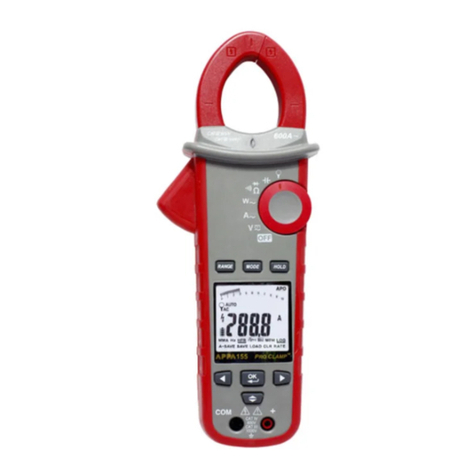
RS PRO
RS PRO RS 155B instruction manual
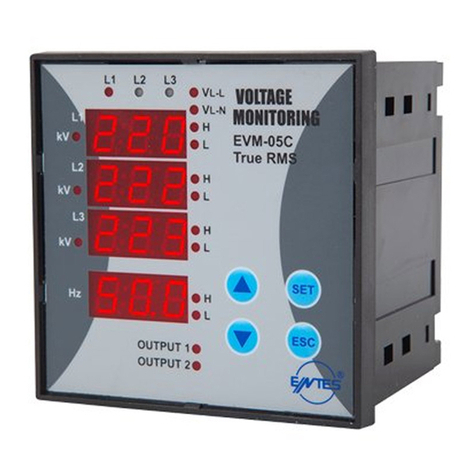
Entes
Entes EVM-05C quick start guide

UNITED PRODUCTS & INSTRUMENTS INC.
UNITED PRODUCTS & INSTRUMENTS INC. UNICO 1100 Service manual

Teledyne
Teledyne 9110AH instruction manual
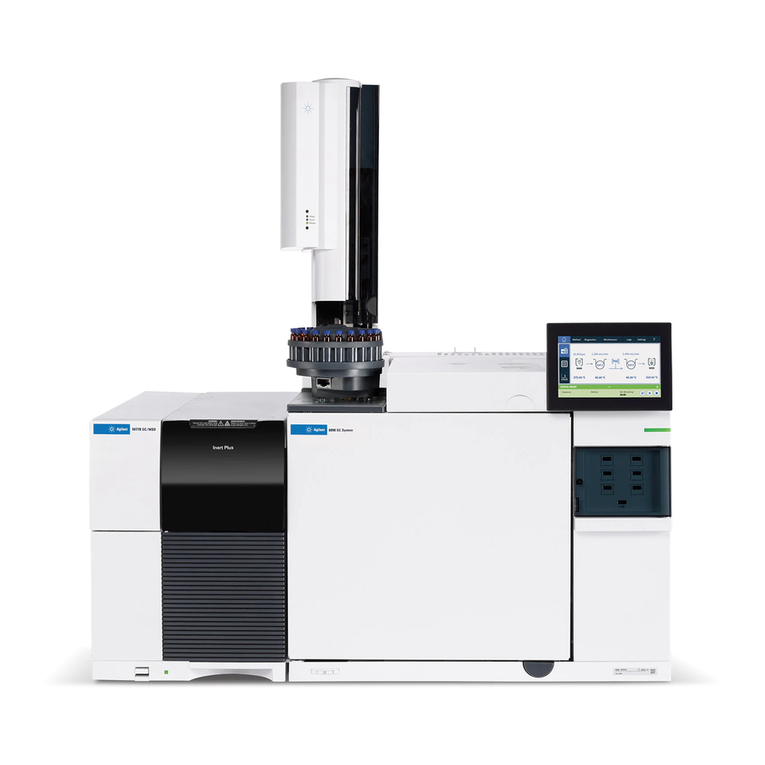
Agilent Technologies
Agilent Technologies 5977B Series operating manual
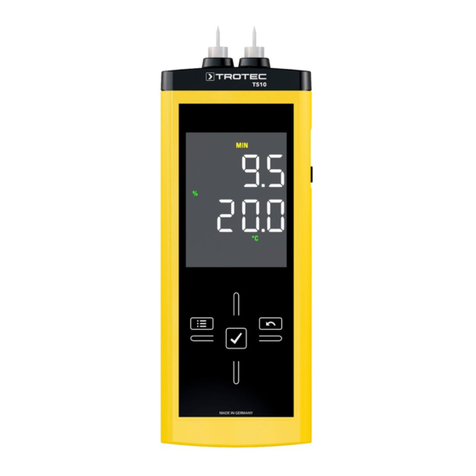
Trotec
Trotec T510 operating manual
